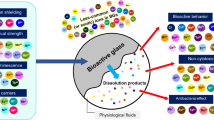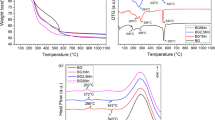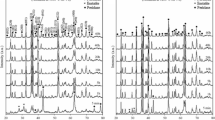Abstract
Controlled delivery of active ions from biomaterials has become critical in bone regeneration. Some silica-based materials, in particular bioactive glasses, have received much attention due to the ability of their dissolution products to promote cell proliferation, cell differentiation and activate gene expression. However, many of these materials offer little therapeutic potential for diseased tissue. Incorporating trace elements, such as zinc and strontium, known to have beneficial and therapeutic effects on bone may provide a more viable bone graft option for those suffering from metabolic bone diseases such as osteoporosis. Rational compositional design may also allow for controlled release of these active ions at desirable dose levels in order to enhance therapeutic efficacy. In this study, six differing compositions of calcium–strontium–sodium–zinc–silicate (Ca–Sr–Na–Zn–Si) glass bone grafts were immersed in pH 7.4 and pH 3 solutions to study the effect of glass composition on zinc and strontium release in a normal and extreme physiological environment. The zinc release levels over 30 days for all zinc-containing glasses in the pH 7.4 solution were 3.0–7.65 ppm. In the more acidic pH 3 environment, the zinc levels were higher (89–750 ppm) than those reported to be beneficial and may produce cytotoxic or negative effects on bone tissue. Strontium levels released from all examined glasses in both pH environments similarly fell within apparent beneficial ranges—7.5–3500 ppm. Glass compositions with identical SrO content but lower ZnO:Na2O ratios, showed higher levels of Sr2+ release. Whereas, zinc release from zinc-containing glasses appeared related to ZnO compositional content. Sustainable strontium and zinc release was seen in the pH 7.4 environment up to day 7. These results indicate that the examined Ca–Sr–Na–Zn–Si glass compositions show good potential as therapeutic bone grafts, and that the graft composition can be tailored to allow therapeutic levels of ions to be released.






Similar content being viewed by others
References
Russell JL, Block JE. Surgical harvesting of bone graft from the ilium: point of view. Med Hypotheses. 2000;55:474–9. doi:10.1054/mehy.2000.1095.
Marsh JL. Principles of bone grafting: non-union, delayed union. Surgery. 2006;24:207–10.
Palmer SH, Gibbons CLMH, Athanasou NA. The pathology of bone allograft. J Bone Joint Surg Br. 1999;81-B:333–5. doi:10.1302/0301-620X.81B2.9320.
Xynos ID, Edgar AJ, Buttery LDK, Hench LL, Polak JM. Ionic products of bioactive glass dissolution increase proliferation of human osteoblasts and induce insulin-like growth factor II mRNA expression and protein synthesis. Biochem Biophys Res Commun. 2000;276:461–5. doi:10.1006/bbrc.2000.3503.
Jell G, Stevens MM. Gene activation by bioactive glasses. J Mater Sci: Mater Med. 2006;17:997–1002. doi:10.1007/s10856-006-0435-9.
Cerruti M, Greenspan D, Powers K. Effect of pH and ionic strength on the reactivity of bioglass 45S5. Biomaterials. 2005;26:1665–74. doi:10.1016/j.biomaterials.2004.07.009.
Moore W, Graves S, Bain G. Synthetic bone graft substitutes. ANZ J Surg. 2001;71:354–61. doi:10.1046/j.1440-1622.2001.02128.x.
Hench LL. Glass and genes: the 2001 W E S Turner memorial lecture. Glass Technol. 2003;44:1–10.
Xynos ID, Hukkanen MVJ, Batten JJ, Buttery LD, Hench LL, Polak JM. Bioglass 45S5 stimulates osteoblast turnover and enhances bone formation in vitro: implications and applications for bone tissue engineering. Calcif Tissue Int. 2000;67:321–9. doi:10.1007/s002230001134.
Christodoulou I, Buttery L, Saravanapavan P, Hench LL, Polak JM. Dose- and time-dependent effect of bioactive gel-glass ionic-dissolution products on human fetal osteoblast-specific gene expression. J Biomed Mater Res B Appl Biomater. 2005;74B:529–37. doi:10.1002/jbm.b.30249.
Aina V, Malavasi G, Fiorio Pla A, Munaron L, Morterra C. Acta Biomater. (in press), corrected proof.
Allan I, Newman H, Wilson M. Antibacterial activity of particulate bioglass against supra- and subgingival bacteria. Biomaterials. 2001;22:1683–7. doi:10.1016/S0142-9612(00)00330-6.
Xie Z, Zhang C, Yi C, Qiu J, Wang J, Zhou J. Failure of particulate bioglass to prevent experimental staphylococcal infection of open tibial fractures. J Antimicrob Chemother. 2008;62:1162–3. doi:10.1093/jac/dkn336.
Hu S, Chang J, Liu M. Study on antibacterial effect of 45S5 Bioglass. J Mater Sci: Mater Med. 2009;20:281–6. doi:10.1007/s10856-008-3564-5.
Love BJ, Popp JR, Goldstein AS. Effect of soluble zinc on differentiation of osteoprogenitor cells. J Biomed Mater Res A. 2007;81A:766–9. doi:10.1002/jbm.a.31214.
Chen D, Waite L, Pierce W. In vitro effects of zinc on markers of bone formation. Biol Trace Elem Res. 1999;68:225–34. doi:10.1007/BF02783905.
Boyd D, Li H, DA T, Towler M, Wall J. The antibacterial effects of zinc ion migration from zinc-based glass polyalkenoate cements. J Mater Sci: Mater Med. 2006;17:489–94. doi:10.1007/s10856-006-8930-6.
Zhu L-L, Zaidi S, Peng Y. Induction of a program gene expression during osteoblast differentiation with strontium ranelate. Biochem Biophys Res Commun. 2007;355:307–11. doi:10.1016/j.bbrc.2007.01.120.
Bonnelye E, Chabadel A, Saltel F, Jurdic P. Dual effect of strontium ranelate: stimulation of osteoblast differentiation and inhibition of osteoclast formation and resorption in vitro. Bone. 2008;42:129–38. doi:10.1016/j.bone.2007.08.043.
Wallace K, Hill R, Pembroke J, Brown C, Hatton P. Influence of sodium oxide content on bioactive glass properties. J Mater Sci: Mater Med. 1999;10:697–701. doi:10.1023/A:1008910718446.
Dias AG, Gibson IR, Santos JD, Lopes MA. Physicochemical degradation studies of calcium phosphate glass ceramic in the CaO-P2O5-MgO-TiO2 system. Acta Biomater. 2007;3:263–9. doi:10.1016/j.actbio.2006.09.009.
Teitelbaum S. Bone resorption by osteoclasts. Science. 2000;289:1504–8. doi:10.1126/science.289.5484.1504.
ISO 11137. Sterilisation of healthcare products. Geneva: International Organisation of Standardization; 2006.
Boyd D, Towler M, Law R, Hill R. An investigation into the structure and reactivity of calcium-zinc-silicate ionomer glasses using MAS-NMR spectroscopy. J Mater Sci: Mater Med. 2006;17:397–402. doi:10.1007/s10856-006-8465-x.
ISO. Biological evaluation of medical devices, In: part 14: identification and quantification of degradation products from ceramics. Geneva: International Organization of Standardization; 1997.
Boyd D, Carroll G, Towler M, Freeman C, Farthing P, Brook IM. Preliminary investigation of novel bone graft substitutes based on strontium-calcium-zinc-silicate glasses. J Mater Sci: Mater Med. 2009;20:413–20. doi:10.1007/s10856-008-3569-0.
Holloway DG. The physical properties of glass. London: Wykeham; 1973.
Yamaguchi M, Igarashi A, Uchiyama S. Bioavailability of zinc yeast in rats: stimulatory effect on bone calcification in vivo. J Health Sci. 2004;50:75–81. doi:10.1248/jhs.50.75.
Ito A. Zinc-releasing calcium phosphate for stimulating bone formation. Mater Sci Eng C. 2002;22:21–5. doi:10.1016/S0928-4931(02)00108-X.
Aina V, Perardi A, Bergandi L, Malavasi G, Menabue L, Morterra C, et al. Cytotoxicity of zinc-containing bioactive glasses in contact with human osteoblasts. Chem Biol Interact. 2007;167:207–18. doi:10.1016/j.cbi.2007.03.002.
Lusvardi G, Zaffe D, Menabue L, Bertoldi C, Malavasi G, Consolo U. Acta Biomater. (in press), corrected proof.
Reginster JY, Meunier PJ. Strontium ranelate phase 2 dose-ranging studies: PREVOS and STRATOS studies. Osteoporos Int. 2003;14:56–65. doi:10.1007/s00198-003-1432-1.
Schrooten I, et al. Dose-dependent effects of strontium on bone of chronic renal failure rats. Kidney Int. 2003;63:927–35. doi:10.1046/j.1523-1755.2003.00809.x.
Granbow B, Muller R. First-order dissolution rate law and the role of surface layers in glass performance assessment. J Nucl Mater. 2001;298:112–24. doi:10.1016/S0022-3115(01)00619-5.
McMillan PW. Glass-ceramics. New york: Academic Press; 1964.
Misra D. Interaction of citric acid with hydroxyapatite: surface exchange of ions and precipitation of calcium citrate. J Dent Res. 1996;6:1418–25. doi:10.1177/00220345960750061401.
Author information
Authors and Affiliations
Corresponding author
Rights and permissions
About this article
Cite this article
Murphy, S., Boyd, D., Moane, S. et al. The effect of composition on ion release from Ca–Sr–Na–Zn–Si glass bone grafts. J Mater Sci: Mater Med 20, 2207–2214 (2009). https://doi.org/10.1007/s10856-009-3789-y
Received:
Accepted:
Published:
Issue Date:
DOI: https://doi.org/10.1007/s10856-009-3789-y




